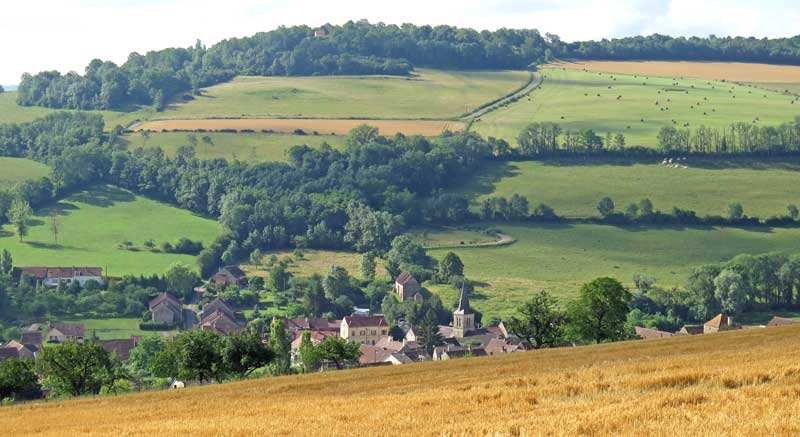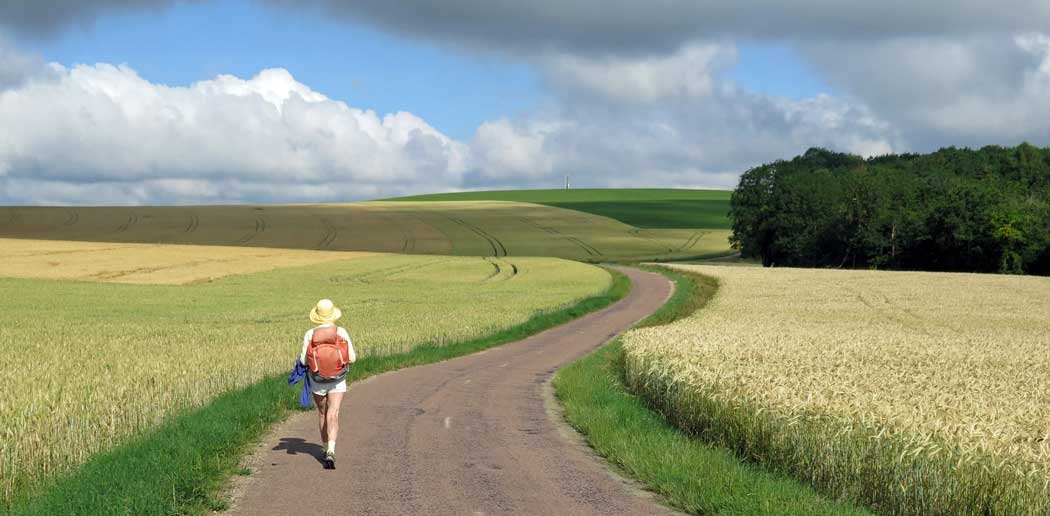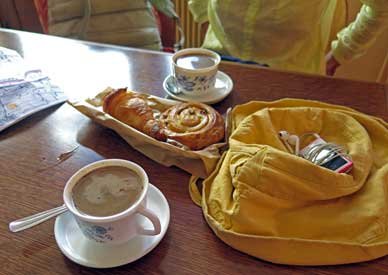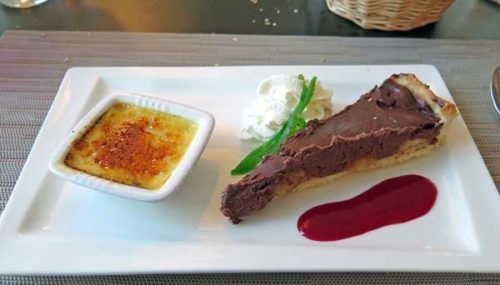Tuesday, 23 June 2015
Distance 24 km
Duration 5 hours 15 minutes
Ascent 180 m, descent 246 m
Map 129 or Map 136 of the
As is the way of best-laid schemes, our plan to have a good breakfast before leaving went awry, due to the lack of a functioning bar in Vitteaux. Instead we swallowed a mouthful of muesli and set off. We had hoped to follow the old railway line but all trace of it had disappeared, so we took a small road through fields of ripe wheat.

The sky was full of clouds but the sun slanted in from the side in a cheerful way and we were glad of its warmth.
Over the first rise we saw the tiny village of Posanges, which was supposed to have a château, but it must have been hidden in the trees.
Our small road became a rough track around the base of a wooded hill, and we emerged at Arnay-sous-Vitteaux, a steep little place in a narrow valley.

Back on the bitumen, we then zig-zagged up the slope behind, which was clad in wheat like an enormous, blonde bison or mammoth. We could have been insects crawling up its flank.
At the top it suddenly flattened out and we swung along for a kilometre or so between fields of greenish young wheat, looking as smooth as velvet from a distance..

Then the land dropped as sharply as it had risen. This side was forested and the road had a couple of hair-pin bends, but Keith noticed a wide track plunging straight down through the trees, no doubt the traditional road, now superseded by the more cautions modern one.

This steep descent ended in the quiet, flower-filled village of Marigny-le-Cahouët and we walked around the corner with hope in our hearts.
We had been on the march for two and a half hours with very little food and we knew that there was supposed to be a bar here, but we were not confident about it.

To our great relief, we found it immediately. There were two doors, one labelled Café and the other Boulangerie/Alimentation, but inside it was one big room, with a couple of locals passing the time of day with the barman.
We bought pastries and coffee and sat down happily to build up our strength and our morale.

Setting off again, we only needed to walk a couple of hundred metres before we rejoined the canal.
On the way we were almost knocked down by a party of American cyclists who seemed to be too busy calling out to each other to notice our presence.
They were followed by a support vehicle and trailer from their tour company, presumably to avoid unnecessary contact with the locals.
Once safely on the towpath, we resumed our placid stroll. The canal curved to and fro, following the lie of the land, and the locks were frequent.
After three or four kilometres we deviated into the pretty village of Pouillenay, hopeful of more refreshments. We went past the church and found, behind a supermarket, a large thriving hotel-restaurant (le Macarena).
It was just after midday and people were crowding in to the dining room, which was full of delicious smells, but as we only wanted coffee we sat in the glassed-in verandah. It was still too cold to sit outside.

After this welcome pause, we walked down the main street to get back on the canal, then wandered on for another half hour.
To pass the time, I listened to my podcast of the history of Rome. I was up to the bit where Julius Caesar was about to finally defeat the Gauls at the battle of Alesia in 52 BC, and capture their leader Vercingetorix.
It was a poignant coincidence that we were at that moment only a couple of kilometres from this fateful place. With some effort I could imagine the present tidy, peaceful landscape as it must have been – torn up by opposing armies, with the Gauls on their rough hill encircled by the besieging Roman soldiers with their double palisade, in all their cleverness and cruelty.
As we approached Venarey-les-Laumes, we deviated once again from the canal, taking a road towards the centre and then a cycle path behind some sports fields.
This brought us directly to the camping ground, a big, well-kept, well-populated place, predictably called the Alesia. The manager was in his office and we had a little chat with him in French, always an enjoyable exercise.
We put up the tent in a grassy corner under some pines and swung into the usual routine of showers and clothes washing, but the time for lunch had passed. We were confident of a good meal this evening and what we needed now was a siesta.

As the sun started to lean to the west, we set off for the centre of town. It was a very different place from Vitteaux, although only twenty kilometres down the river. Where Vitteaux was decaying, Venarey was booming.
We had been to Venarey before (although not on foot), so we had some recollection of it, but the part that we remembered, in front of the station, had been swept away and replaced by a whole new precinct with a huge shopping mall and a glamorous paved promenade lined with eateries. There were red gravel footpaths, fresh white lines on the road and a row of newly-planted trees.
At the far end we found the corner restaurant where we had dined last time, but it had succumbed to the march of progress and was now defunct.

For apéritifs we chose a bar with a terrace adorned by green umbrellas, but we sat inside, as it was cold – only the smokers were outside.
People streamed past on their way to and from the station, and we wondered whether it was the railway that made the difference betweeen here and Vitteaux.
After apéritifs we walked along to an elegant new restaurant called l’Esprit, so elegant and understated that we had almost missed it on our first reconnaissance.
Inside, the décor was sparse – all black and white except for the primary colours of the chairs and the abstract art on the walls.
The menu was €18 for three courses. To begin, Keith ordered a smoked salmon terrine with various pretty accompaniments, and I had oeufs en meurette, a traditional Burgundian dish according to the menu, which turned out to be poached eggs and mushrooms in a rich, dark soup. We were both very pleased with our choices.
After that we both had pavé de boeuf bourgignone, which was steak cooked with vegetables in a wine sauce, a typical dish of the region.

For some reason the mashed potato that came with it was a distressing mauve colour, but it tasted normal.

Then there was a long pause before our final course appeared. It seemed that the kitchen had run out of the crème brûlée that Keith had ordered. In the end he got a chocolate tart, plus a miniature crème brûlée, so he was happy.
I got cheese, which I spirited away, together with four rounds of bread, for another time.
When we were paying the bill we saw a group of people being told that they could not come in – it was too late. Seemingly the same new broom was in action here, as at Pouilly.
Previous day: Pouilly-en-Auxois to Vitteaux





